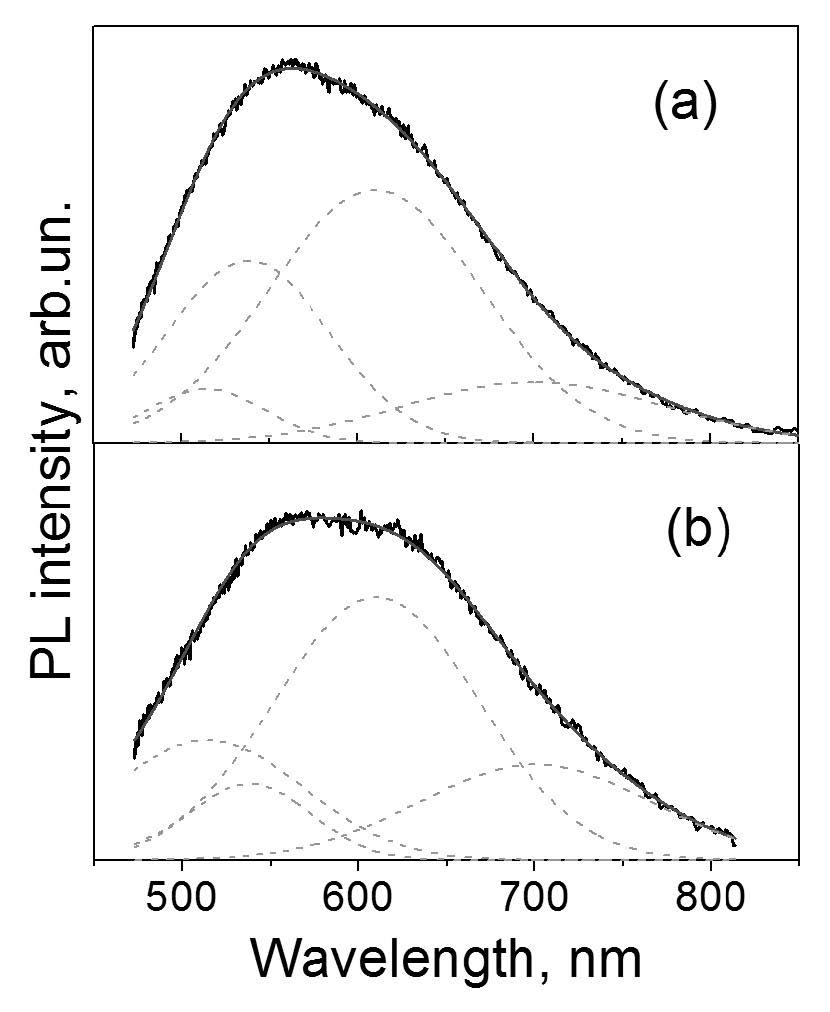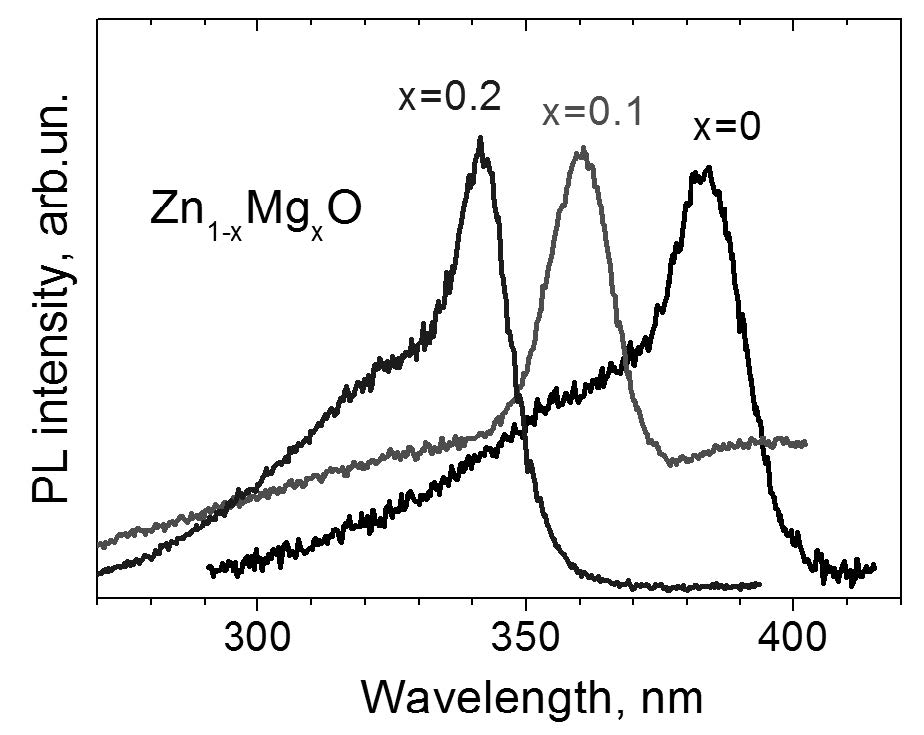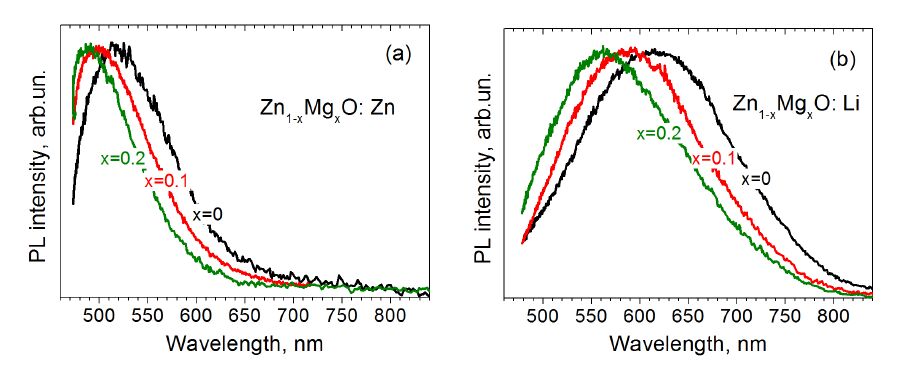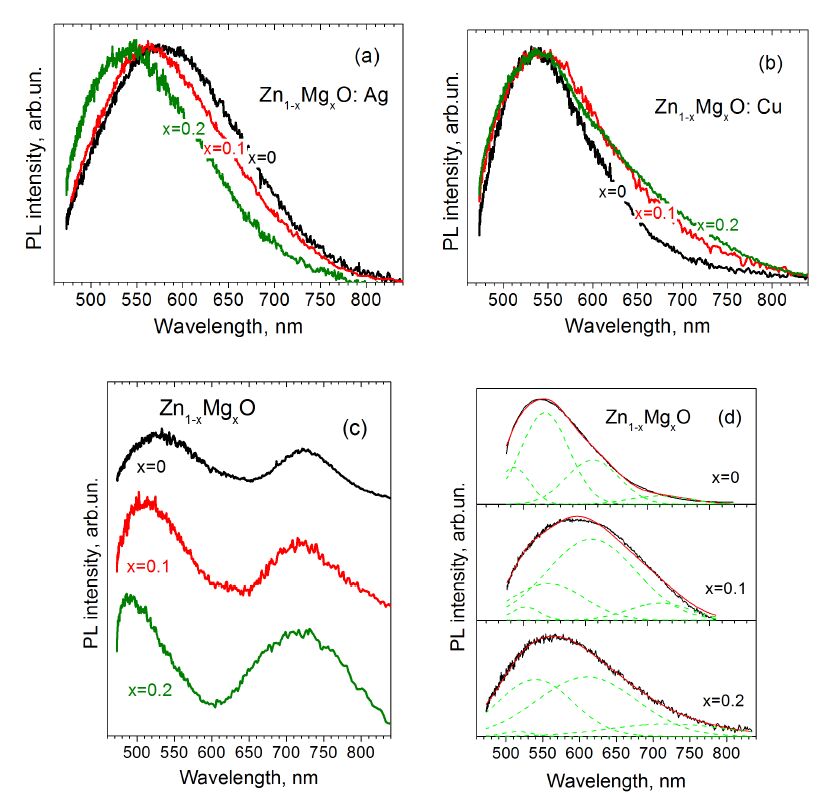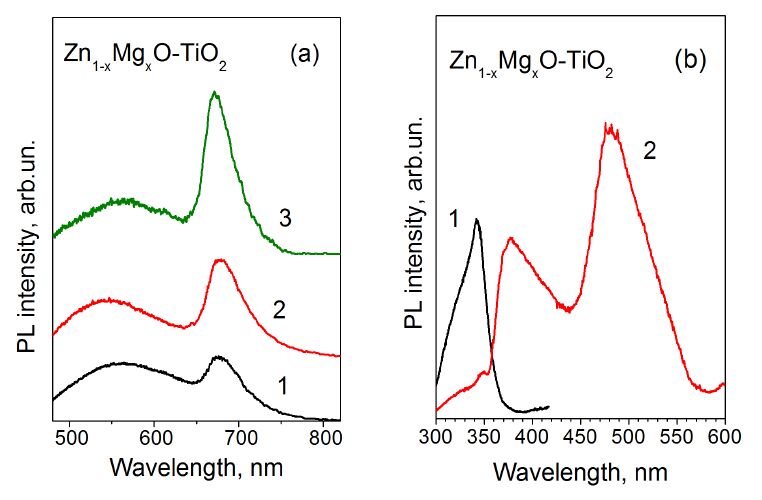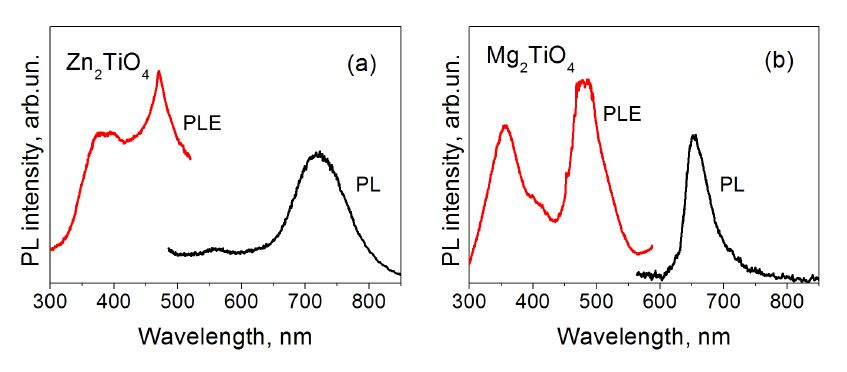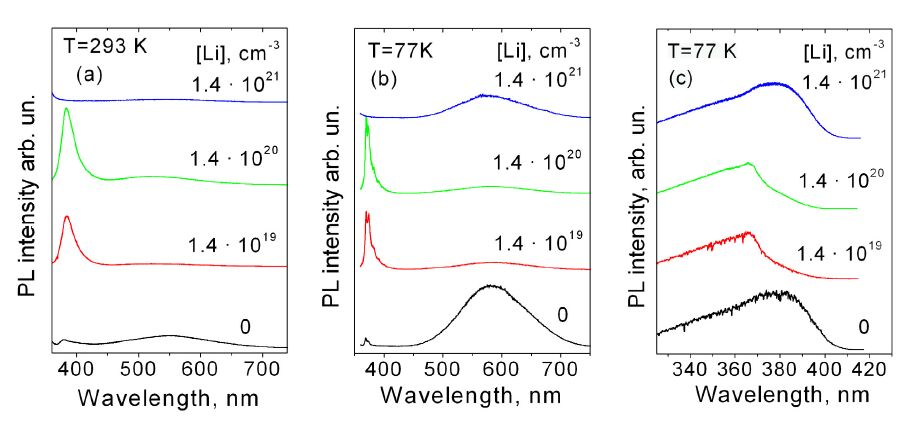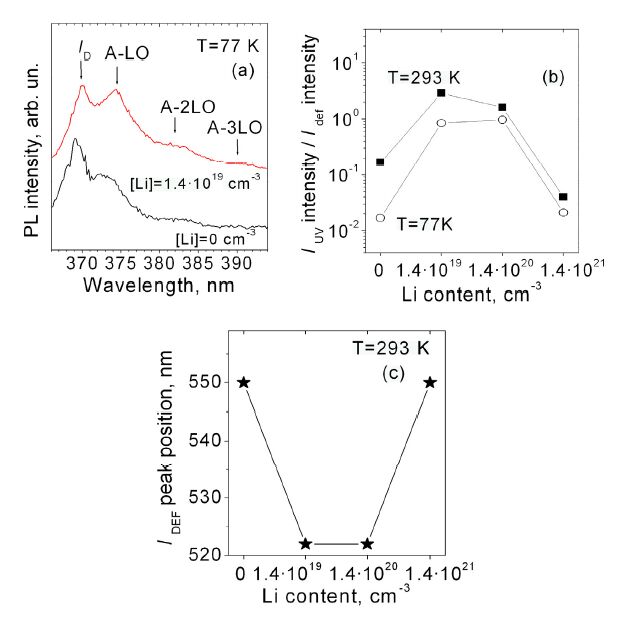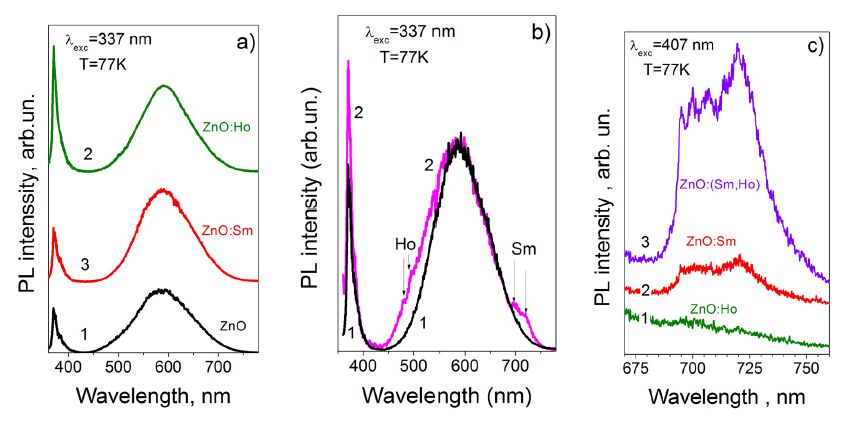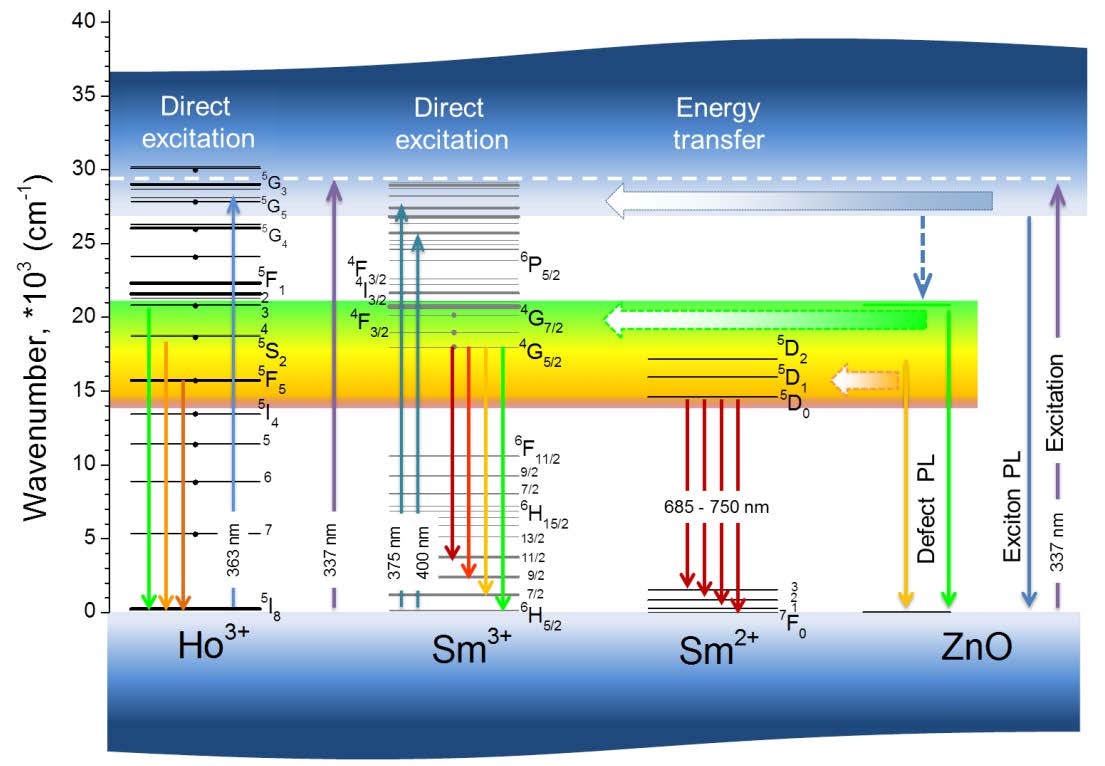1. Introduction
Unique electrical and optical properties of ZnO side by side with its high thermal and optical stability, high radiation hardness, low cost and the absence of toxicity make this compound an excellent candidate for electronics device applications [1,2]. In particular, zinc oxide attracts much attention as a promising material for emitters of both UV and visible light [1,3]. Visible emission of ZnO is known to consist of a number of bands related to different lattice defects. The large LO-phonon energy (72 meV) and strong phonon-electron coupling in ZnO cause the broadening of emission bands, which leads to their essential overlapping. As a result, defect-related emission in ZnO exhibits itself as a broad unstructured band spreading from blue to red spectral regions. This peculiarity makes ZnO a prospective phosphor for white-light emitters with a high color rendering index [3]. At the same time, such an overlapping impedes the separation of broad band components and the determination of their peak positions, which can account for the discrepancies in reported data. The origin of emission centers and carrier transitions responsible for emission in ZnO are also the subject of discussion thus far. So, further investigations of ZnO defect-related emission and the influence of different treatments on its spectrum shape and intensity are required. Besides, the possibility of UV emission enhancement in polycrystalline ZnO should be found. In present paper, our recent results on the investigation of light emitting properties of polycrystalline ZnO and ZnO-based materials [4,5,6,7,8,9] are given. It is shown that tuning of sintering conditions and composition of starting charge enables monitoring luminescent spectrum from the UV to the red.
2. Materials and Method
Sintering of ceramics is one of the most attractive methods of ZnO material fabrication due to its simplicity, low cost and the possibility to modify material characteristics in wide range by introduction of different additives in the starting charge. In turn, screen-printing is a very simple and viable technique to produce thick filmsof various materials. It ensures maximum material utility and offers a suitable method for preparing films on large area substrates.
Investigated samples were undoped and doped with I group elements ZnO, ZnMgO and ZnMgO-TiO2 ceramics as well as undoped and doped with Li+, Ho3+ and Sm3+ ions polycrystalline ZnO layers prepared by a screen-printing method [10].
Ceramic samples were formed of the mixture of ZnO, MgO and TiO2 powders (all of 99.99% purity) with distilled water or LiNO3, AgNO3 and CuSO4 aqueous solutions. In Zn1−xMgxO samples, x was varied from 0 to 0.20. In doped samples, impurity concentration was about 1018 cm-3. In Zn1−xMgxO-TiO2 composites, x = 0.30-0.40 and TiO2 contents were 10 and 12.5 wt%. To investigate the influence of adding TiO2 on ZnMgO alloy emission, ZnTiO3, Zn2TiO4, MgTiO3 and Mg2TiO4 titanates were also prepared. For this purpose, ZnO, MgO and TiO2 oxides were mixed according to stoichiometry ratio. The samples were dried at room temperature, sintered in air for 3 h at TS = 1100 ℃ and cooled with the furnace. A number of samples were sintered in the N2 flow or Zn vapor. In the last case, the samples were located in a closed alumina crucible with metallic Zn scraps and annealed in N2 flow. In all cases, dense ceramics with average sizes of 10 × 3 × 2 mm3 were obtained. Sintered ceramic samples were cut transversally and the PL was measured from the cleft surface.
The films were produced by screen-printing of a ZnO-based paste on the non-polished (1012) Al2O3 substrates of 1 × 1 cm2 areas, dried at room temperature under atmospheric conditions and sintered in air atTS = 800-1000 ℃ for 30 min and 60 min. The paste was prepared of Sigma-Aldrich ZnO powder (99.99% purity) mixed with distilled water or LiNO3 aqueous solution. To produce the films doped with rare-earth (RE) ions, the ZnO powder was mixed with RE2O3:H2O:HCl solutions of different composition. The Ho2O3 (99.95%) and Sm2O3 (99.95%) were used as the RE sources. The concentration of Li dopant in the films varied from 1.4 × 1019 to 1.4 × 1021 cm-3, while concentration of rare-earth ions was in the range of (2-4) ×1020 cm-3. The thickness of sintered films was about 40 µm.
The photoluminescence (PL) and PL excitation (PLE) spectra of the films and ceramic samples were recorded using a SDL-2 spectrometer (LOMO, St. Petersburg) equipped with a photomultiplier tube sensitive in 200-900 nm spectral range. The PL was excited by a pulsed N2-laser (337.1 nm; the pulse duration was 7 ns; the repetition frequency was 100 Hz), a 407-nm continuous-wave diode laser (~40 mW) and by a Xe lamp (150 W). The latter was also used for PLE measurements. X-ray diffraction (XRD) study was realized using X-ray powder diffractometer ARL X’TRA with the Cu Kα1 and Cu Kα2 radiation. The PL and PLE investigations were performed at 77K and 293K.
3. Results and Discussion
3.1. Ceramic samples
3.1.1. Zinc oxide
The most of investigators believe that defect-related emission in intentionally undoped ZnO consists of green and orange ones [1,2]. The green emission, in its turn, includes two bands, one of which is due to stoichiometric Zn excess and the other is related to residual copper impurity [1,2]. Self-activated orange emission is observed, as a rule, in the samples annealed in air or oxygen ambient and is associated with stoichiometric oxygen excess [11,12,13,14]. Peak positions of emission bands, however, have not been determined reliably. In particular, quite different values from 570 to 640 nm can be met in the literature for peak position of self-activated orange band [11,12,13,14]. One of the reasons of such a spread can be the fact that the separation of overlapping bands and determination of their peak positions are often made using Gaussian fitting procedure. At the same time, Gaussian deconvolution of a broad unstructured band will be rather ambiguous if the number and pick positions of components are unknown. More reliable results can be obtained when the positions of some bands are preliminarily established. In the present work, self-activated orange band was separated by Gaussian deconvolution of PL spectrum using peak positions of the other components obtained experimentally.
To determine peak positions of green self-activated and Cu-related bands, PL spectra of ZnO ceramics sintered in Zn vapor as well as doped with Cu were measured. It was found that the samples sintered in Zn vapor demonstrated extremely intense green emission peaked at 515 nm (Fig.1, curve 1), whereas green band with peak position at 540 nm dominated in PL spectra of Cu-doped samples (Fig.1, curve 2). It should be noted that emission in red spectral region was also observed in undoped ZnO. This emission looked usually as a shoulder on the longer-wavelength side of the orange one, but sometimes exhibited itself as a distinct band at about 700 nm [12,15]. In some of our undoped ZnO samples, a distinct red PL band peaked at 720 nm was observed in addition to green and orange emissions (Fig.1, curve 3). PL spectrum of undoped ZnO sample sintered in air and its Gaussian deconvolution are shown in Fig.1 (curve 4). The deconvolution was made taking into account obtained peak positions for two green bands (515 and 540 nm) as well as for self-activated red one (720 nm). As a result, the orange band peaked at 610 nm was separated.
It should be noted that self-activated orange emission in ZnO is usually ascribed to oxygen interstitials [1,11,12,13,14]. At the same time, essential enhancement of orange emission side by side with the quenching of green one was observed in high-purity ZnO powder after annealing in vacuum, a layer of metallic zinc being formed on the cold end of silica tube in which the annealing was performed [16]. Based on these facts, it was concluded that emission centers responsible for orange emission are related to zinc vacancies formed due to zinc evaporation [16].
This conclusion is confirmed by our experiments. It was found that sintering of undoped ZnO samples in N2 flow resulted in the increase of contribution of orange emission to PL spectrum, this effect being more pronounced in the sample surface with respect to its bulk (Fig.2). In fact, one can expect that higher density of zinc vacancies should be formed due to zinc evaporation i) on the surface of the sample with respect to its bulk; ii) under sintering in N2 flow with respect to that in immobile air due to removal of evaporated Zn from annealing zone by gas stream.
3.1.2. ZnMgO alloys
In recent years, ZnMgO solid solutions attract much attention as promising materials for UV-light emitters. On the other hand, alloying with MgO results in the enhancement of ZnO defect-related emission and, so, these alloys can be considered as potential candidates for visible-light phosphors. At the same time, reported data on the visible emission in ZnMgO compounds are rather scarce and controversial. To investigate the influence of alloying MgO with ZnO on the intensity and spectrum of defect-related emission in ZnMgO solid solutions, undoped and doped with Zn, Cu, Li and Ag ceramics with different Mg content were sintered and their luminescent characteristics were measured. Because of crystal structure dissimilarity between hexagonal ZnO and cubic MgO, these oxides do not show a complete solubility over the entire composition range. With increasing Mg content, at first ZnO-based wurtzite phase is formed, then the separation of the phases with wurtzite and rock-salt structures takes place and, at last, MgO- based rock-salt alloy becomes predominant [17]. XRD patterns of prepared ceramics were measured and analyzed earlier in [18]. It was shown that both hexagonal and cubic ZnMgO phases were formed under sintering, and MgO solubility limit in hexagonal phase was found to be 20 at% [18]. Since only hexagonal phase exhibited noticeable visible emission, Zn1−xMgxO samples with x = 0-0.20 were prepared for the PL and PLE measurements.
PL spectra of undoped Zn1−xMg xO ceramics look as broad unstructured bands which are similar to those in ZnO. The PLE spectra of undoped Zn1−xMgxO samples with different x are plotted in Fig.3. The shift of PLE peak, whose position coincides with that of free exciton [18], toward short-wavelength side with increasing x is the evidence of bandgap broadening due to formation of hexagonal ZnMgO solution, which was proved by X-ray diffraction study [18]. It was found that PLE spectra are identical for all PL bands observed in both undoped and doped samples with the same x.
To perform Gaussian deconvolution of the PL spectra of MgxZn1−xO samples, the behavior of visible band components depending on x should be clarified. For this purpose, PL spectra of all the doped and undoped Zn1−xMgxO samples were measured under excitation by the light λEXC = 320 nm corresponding to band-to-band absorption and were analyzed. In ceramics sintered in Zn vapor, the blueshift of self-activated green band from 515 to 485 nm was found to occur with increasing x from 0 to 0.20 (Fig.4a).
Similar effect was also observed in ceramics doped with Li and Ag. Doping of ZnO with these impurities was shown to cause the appearance of intense orange bands at 600 and 580 nm,
respectively [19]. Alloying with MgO resulted in the shift of both Li- and Ag-related bands toward short-wavelength side (Fig.4b,Fig.5a). At the same time, any shift of Cu-related PL band was not observed in Zn1−xMgxO samples doped with Cu (Fig.5b). Comparison of the PL spectra for undoped samples with different x demonstrating distinct red band showed that peak position of this band (720 nm) was independent of x (Fig.5, c).
PL spectra of undoped Zn1−xMgxO samples with different x are plotted in Fig.5d. Gaussian deconvolution was performed taking in account determined above peak positions of self-activated green and red bands as well as Cu-related one. As a result, orange PL band with the same peak position at 610 nm for each x was separated. One can see that the contribution of this band to the observed PL at first increased and then decreased with increasing x.
Obtained results indicate that two types of emission bands are present in PL spectra of investigated samples: i) the bands whose peak positions are not influenced by Mg content (self-activated orange and red as well as Cu-related ones); ii) the bands whose peak positions show some blue-shift with increasing Mg content (self-activated green as well as Li- and Ag-related ones). Thus, energy levels related to corresponding emission centers demonstrate different reaction to band gap broadening due to alloying ZnO with MgO, which testifies to different interaction of these centers with the host lattice. For the first-type centers, two possibilities should be considered: i) energy level is pinned to the involved allowed band from which carrier recombination on the given center occurred; ii) the emission is caused by an intra-defect transition, excited and ground states of the center being weakly coupled to the band properties of the host lattice. The latter has been proposed for Cuzn acceptor in ZnO [1,2]. For orange and red self-activated centers, the former possibility seems to be more probable. These bands are usually ascribed to electron transitions from c- band or shallow donors to deep acceptors [1,2,11,12,13,14,15]. The second type centers show the shift of their energy levels with respect to the involved allowed band under bandgap broadening. This shift is about 0.20 eV at x = 0.20 for all second type centers, which is twice as little as that of free exciton (see Fig.3). One can think, therefore, that energy levels of these centers shift equally with respect both to c- and v- bands. It should be noted, however, that electron-hole transitions responsible for specific emission bands in ZnO remain so far highly disputable throughout the literature and further studies in this field are required.
3.1.3. ZnMgO-TiO2 composites
Above results show that bright blue, green, yellow and orange emissions can be obtained in ZnMgO solid solutions by corresponding treatments, while the emission in red spectral range is rather week. At the same time, the enhancement of red emission will enable the fabrication of white-light phosphors based on these alloys.
It is known that zinc and magnesium titanates exhibit strong red emission [20,21]. One can expect that new effective phosphors can be developed using these compounds. In particular, it can be assumed that introduction of titanium oxide in the starting mixture of zinc and magnesium ones will lead to the appearance of red component in emission spectra of prepared ceramics. To verify this assumption, ZnMgO-TiO2 composites as well as ZnTiO3, Zn2TiO4, MgTiO3 and Mg2TiO4 titanates were sintered and their photoluminescence characteristics were measured. As Fig.6a shows, a distinct red band peaked at 670 nm is present in the PL spectra of ZnMgO-TiO2 composites side by side with a broad blue-orange one inherent in ZnMgO alloys. One can see that relative intensities of these bands can be controlled by the change of both TiO2 and MgO contents in the starting charge, the peak position of the red band remaining the same.
It was found that the PLE spectra of the broad band components (Fig.6b, curve 1) are identical to those for Zn1−xMgxO alloys with x ≥ 0.20 (see Fig.3), whereas PLE spectrum of the red band is quite different (Fig.6b, curve 2).
Such a difference can indicate that emission centers responsible for the red PL band in composite samples are not local defects in ZnMgO, but relate to some other substance whose inclusions can form in the host lattice under sintering. Recent structural investigations of ceramics prepared of ZnO and TiO2 powders showed that ZnTiO3 and Zn2TiO4 precipitates were formed in ZnO matrix under sintering and became noticeable at Ti content of 2-3 at% [22,23]. One can suppose, therefore, that the formation of both zinc and magnesium titanates takes place in ZnMgO-TiO2 composites. To verify this supposition, PL and PLE spectra of prepared zinc and magnesium titanates were measured and compared with those for ZnMgO-TiO2 composites.
It was found that ZnTiO3 and MgTiO3 ceramics demonstrated visible emission in wide spectral range, but the intensity of this emission was extremely week. At the same time, red PL bands peaked at 720 and 660 nm were observed in the PL spectra of Zn2TiO4 and Mg2TiO4 samples, respectively (Fig.7), the PL intensity of Mg2TiO4 ceramics being more than ten times stronger than those of Zn2TiO4 ceramics. The PLE spectra of these bands (Fig.7) are similar to those for the red emission in ZnMgO-TiO2 composites (Fig.6b).
The data plotted in Figs.6 and 7 demonstrate that PL and PLE spectra in Zn2TiO4 and Mg2TiO4 samples exhibit the same characteristic features as those in composites, namely, a distinct red band with a full width at half maximum (FWHM) of about 0.2 eV and an intense long-wavelength PLE maximum in 450-550 nm spectral range which are never observed in ZnMgO alloys. In zinc titanate, however, peak position of the red band (720 nm) is far enough from that in composite material (670 nm) and blue-green PLE maximum is shifted to shorter wavelengths with respect to that in ZnMgO-TiO2 ceramics. At the same time, the long-wavelength PLE maxima are practically identical for Mg2TiO4 and composite materials and only a slight shift is observed between peak positions of red PL bands in Mg2TiO4 and ZnMgO-TiO2 samples (660 and 670 nm, respectively). Based on these facts and taking into account the weakness of red PL band in Zn2TiO4 with respect to that in Mg2TiO4, one can conclude that Mg2TiO4 inclusions formed in composite material under sintering are responsible for the red emission in Zn1−xMgxO-TiO2 ceramics. This effect seems to be quite understandable, because, at x > 0.20, “surplus” MgO that does not dissolve in ZnO can take part in the formation of Mg2TiO4 phase. In fact, the greater the MgO content, the higher the red emission intensity in composite samples. To elucidate the origin of red emission and the mechanism of its excitation further investigations are required.
The emission of prepared composites under UV excitation (Fig.6a) is perceived with the naked eye as a bright white light. The tinge of this light can be made warmer or colder by the change of starting charge composition. Obtained results show that ZnMgO-TiO2 ceramics are promising materials for the development of white-light emitters.
3.2. Polycrystalline films
3.2.1. Effect of Li-doping on the PL of screen-printed ZnO films
An interest to Li-doped ZnO has been motivated mainly by high perspectives for realizing p-type conductivity. In fact, it was theoretically predicted that Li incorporation on the Zn-lattice site (LiZn) produces a shallow acceptor level [24]. In some reports, it has been demonstrated that upon Li doping at temperatures below 700 ℃ the shallow acceptors with binding energy of about 300 meV are introduced [25,26]. These shallow acceptors participate in donor-acceptor pair recombination band at 3.05 eV [26]. However, the most of the experimental reports supposed that LiZn is a deep acceptor with the binding energy of about 800 meV and is responsible for yellow luminescence at 2.0-2.2 eV ascribed to shallow donor to deep acceptor recombination [19,27,28]. Therefore, Li can be used also for producing visible luminescence in the yellow spectral range.
The undoped ZnO films were sintered at 500-1000 ℃ for 0.5-1 h. It has been found that the films annealed at temperatures lower than 800 ℃ show intense UV emission and weak defect-related PL band. The PL spectra of the films sintered at 800 ℃ and higher temperatures showed gradual decrease of the UV luminescence and the increase of defect-related PL.
Tostudy the effect of Li-doping, the ZnO films with different Li content (1.4 × 1019, 1.4 × 1020 and 1.4 × 1021 cm-3) were sintered in air at 800 ℃ for 0.5 h. The room-temperature and low-temperature luminescence spectra of Li-doped ZnO films are shown in Fig.8a and Fig.8b, respectively. In the PL spectra, the UV band, IUV, and the wide defect-related band, IDEF, in the green-orange spectral range are observed. The UV band is a superposition of exciton-related bands of ZnO. As the temperature is decreased from 293 to 77 K, the UV band divides into several clearly resolved PL peaks that can be ascribed to a donor-bound exciton band ID (369 nm) as well as to three phonon replicas of free A-exciton (374, 383 and 392 nm) (Fig.9a).
The relative intensity of the UV and visible defect-related bands are found to depend significantly on Li content. The undoped film shows rather low intensity of the UV band, while the doped ones show strongly enhanced UV emission. At the same time, the highly doped film ([Li] = 1.4 × 1021 cm-3) does not demonstrate any exciton-related PL both at room and low temperatures. Moreover, in the room-temperature PL spectra of the highly-doped film, the defect-related PL is decreased too. The ratios of the intensities of the UV and defect-related PL bands (IUV/IDEF) shown in Fig.9b enables estimating the structural performance of ZnO films. The best PL properties are found for lightly doped films ([Li] = 1.4 × 1019 cm-3) whereas the highly doped film is the worst.
An improvement of structural perfection of ZnO films upon Li-doping is proved by the excitonic spectra, where the increase in the intensity of the phonon replicas of free A-exciton relative to that of bound exciton emission is found (Fig.9a). In the room-temperature PL spectra, this effect appears in the shifting of the UV band maximum from 378 nm in the films with low UV emission to 384 nm in the films with strongly enhanced UV PL. Spectral position of the IDEF band maximum also changed in the doped films. It varies in the range of 522-550 nm in different samples and shows the shortest wavelength position for the Li-doped films with [Li] = 1.4 × 1019 and 1.4 × 1020 cm-3 (Fig.9c). This indicates that the defect-related PL band is complex and composes of at least two overlapping PL bands (green and orange bands).
The low-temperature PLE spectra recorded in the maximum of the defect-related band are shown in Fig.8c. In the PLE spectra, the band-to-band (λEXC < 365 nm) and free exciton (~369 nm) absorption features as well as some defect-related absorption peak at about 380-385 nm are found. The defect-related peak is observed in the low-temperature PLE spectra of the orange PL band, but is not found for the green emission.
The results of the PL study clearly indicate that Li-doping affects strongly crystal structure of the films. The doping with Li of low concentrations improves it, while the high concentration of Li dopant degrades it. The decrease of the total PL intensity upon high Li concentrations can be due to concentration’s quenching of the PL intensity by dopants. In the films with improved crystal structure, the green PL band dominates, while in more defective films (the undoped and highly doped films), the orange emission prevails. At the same time, neither a pronounced increase in the intensity, nor the evident shift of the IDEF peak position are observed in the ZnO:Li films as compared with the undoped films. This hinders an identification of Li-related emission in the doped films. So, in spite of the fact that the orange band is often ascribed to LiZn acceptor we cannot exclude that in the ZnO:Li films this band originates from the intrinsic defects of ZnO mainly.
The effect of Li-doping on the ZnO crystallization processes is proved by the XRD study. The XRD patterns of undoped and Li-doped ZnO films show the peaks corresponded to polycrystalline wurtzite ZnO without preferable grain orientation (Fig.10a). For doped film with Li content of 1.4 × 1019 cm-3, the diffraction peaks are shifted towards smaller angles and the peaks became narrower as compared with the undoped film, while further increase of Li concentration produces the opposite effect, i.e. the peak shifting to larger angles and FWHM increase. Assuming a homogeneous strain across the films, the crystallite sizes were evaluated from the FWHM for different XRD peaks using the Scherrer’s equation. The representative behavior of the grain sizes in dependence on Li content is shown in Fig.10c for a (002) diffraction peak. The introduction of Li in low concentration is found to promote nanocrystal growth, while high Li content hinders this process. The nature of the former effect is not clear now, while the latter can be caused by segregation of insoluble Li atoms at the grain boundaries, which suppress growth of nanocrystals [29]. The increase of the grain sizes upon Li-doping results in lower density of extended defects such as subgrain boundaries. It can be assumed that the increase of grain sizes affects also the formation of vacancy and interstitial defects inside the crystallites as well as stimulates defect diffusion during crystal growth.
Therefore, Li doping in low concentration of 1.4 × 1019 cm-3 enables producing the films with enhanced UV emission, reduced density of crystalline defects and larger grain size. This enables decreasing thermal budget for film production. Similar effect of improvement of optical and structural properties of zinc oxide nanowires after indium doping have been reported in [30 and references ibid]. At the same time, introduction of high amount of Li produces an additional structural disordering and the degradation of the whole PL spectrum. The obtained results indicate that Li-doping is seems to be ineffective in producing an intense yellow luminescence in the films studied.
3.2.2. Effect of RE-doping on the PL of screen-printed ZnO films
Introduction of rare-earth (RE) ions in semiconductor materials is considered as an efficient way to produce emission in specific spectral range. The 4f orbital of RE ions is shielded from the surroundings by the filled 5S2 and 5P6 orbitals that minimized the influence of the host lattice on the optical transitions within the 4f configuration [31]. Moreover, their 4f states only weakly interact with the host lattice, and therefore the energy differences are nearly constant, leading to almost the same emission spectra in different host lattices [32,33].
To achieve PL bands in the green and red spectral regions the ZnO films were doped with Ho and Sm ions, respectively. The RE ions of two types were introduced in the ZnO both separately (RE doped films) and simultaneously (codoped films) from the corresponding oxides during film sintering. The latter was done in the air at 1000 ℃ for 1 h. The concentrations of Ho and Sm dopants were about 2 × 1020 cm-3 and in the range of (2-4) × 1020 cm-3, respectively.
The low-temperature PL spectra of the undoped and RE doped films under ZnO band-to-band excitation are presented in Fig.11. The PL spectra of the films doped with one type of RE ions (Fig.11a) show the same PL bands as the undoped ZnO with no variations in the PL band position. No fingerprint of the self-emission of Ho3+ or Sm3+ ions is found. In the PL spectra of the Ho-doped film, the intensity of the UV band exceeds that of the visible PL. This attests that the doping of ZnO with Ho3+ ions enables crystalline structure of the films to be improved.
In the PL spectra of the codoped films (Fig.11b), a significant quenching (more than 5 times) of total PL intensity was observed, the UV emission being quenched prominently. On a background of the weak defect-related PL of ZnO host, some additional peaks in the 460-500 nm and 680-730 nm spectral ranges appeared. The latter set of narrow peaks is found on a background of red self-activated PL band at ~720 nm. These peaks can be ascribed to the emission of RE ions themselves. By using the Dieke diagram from [31] the peaks in the range of 460-480 nm can be assigned to the 5F1→5I8 transitions in Ho3+ ions (Fig.12). At the same time, the peaks in 680-730 nm range cannot be attributed to the optical transitions in Sm3+ ions that show no emission in this region. The most probable origin of this emission is the Sm2+ ions whose 5D0→7FJ (J = 0, 1, 2) transitions can produce sharp PL peaks in the range of 695-710 nm. These peaks are also found in the PL spectra of Sm-doped and codoped films under excitation with 407 nm laser line which corresponds to direct excitation of Sm3+ ions (Fig.11c).
The mechanism for Sm3+ to Sm2+ reduction is still debated. It has been supposed that it follows the reaction as Sm3+ + e− = Sm2+ and the stability of Sm2+ ions is determined by the oxygen-lack environment, i.e. by oxygen vacancies [33]. In such a case, when the Sm3+ ion inserted in host lattice captures a photogenerated electron, a metastable Sm2+ appears. Due to band bending at the grain surface, the photogenerated holes will migrate towards the surface and recombine with electrons trapped at the surface levels or convert metastable Sm2+ ions into stable Sm3+ ones [33].
It should be noted that PL intensity from RE ions is rather low and is observed al low temperatures only. At the same time, the PL spectrum excited with 337 nm laser line which cannot excite directly Ho3+ and Sm3+ ions also shows RE ion emissions of intensity comparable with those of native defects. This implies an energy transfer from ZnO lattice to RE ions, and the native ZnO defects can be considered as a pathway for this process (Fig.12).
4. Conclusion
In order to reveal the possibility of producing effective UV- and visible-light emitting phosphors using ZnO and ZnO-based compounds, the emission of undoped and doped ZnO, ZnMgO and ZnMgO-TiO2 ceramics as well as ZnO polycrystalline screen-printed films was studied.
Defect-related emission of undoped ZnO ceramics exhibited itself in blue-orange spectral region and was shown to include green (515 nm), orange (610 nm) and red (720 nm) self-activated bands as well as the band related to residual Cu impurity (540 nm). The doping with Li and Ag led to the appearance of bright PL bands at 600 and 580 nm, respectively. Alloying ZnO with MgO was found to cause some blueshift of green self-activated as well as Li- and Ag-related bands, while Cu-related as well as orange and red self-activated ones did not change their positions, which indicated different interaction of corresponding emission centers with the host lattice. It was shown that the introduction of TiO2 into the mixture of zinc and magnesium oxides resulted in the appearance of bright red PL band at 670 nm. The comparison of PL and PLE spectra for ZnMgO alloys and ZnMgO-TiO2 composites led to the conclusion that the red band was due to the inclusions of Mg2TiO4 titanate formed in ZnMgO matrix under sintering. As a result, the emission of ZnMgO-TiO2 composites consists of broad blue-orange and distinct red bands and is perceived by the naked eye as bright white light.
The screen-printed undoped ZnO films showed intense UV and weak defect-related emissions when being sintered at temperatures lower than 800 ℃. At higher temperatures, the UV luminescence decreased and the self-activated defect-related PL increased. The doping of ZnO films with Li at 800 ℃ enabled to enhance UV emission and to improve structural properties of the films. It is found that the effect of Li-doping on the PL properties of ZnO films is closely connected with the influence of Li on the development of film microstructure via the control of crystal sizes and concentration of native point defects. In the PL spectra of Ho and Sm codoped ZnO, the PL peaks ascribed to optical transitions in Ho3+ and Sm2+ ions were identified, and the mechanism of Sm3+ to Sm2+ reduction was discussed.
Obtained results show that intense UV emission can be obtained in polycrystalline screen-printed ZnO films by corresponding heat treatment. At the same time, ZnMgO-TiO2 composites can be considered as promising materials for white-light emitters.
Acknowledgments
This work was supported by the National Academy of Science of Ukraine via the projects III-10-12 and III-10-15. We also would like to thank Yu. O. Polishchuk for XRD measurements.
Conflict of Interest
The authors declare no conflicts of interest regarding this paper.









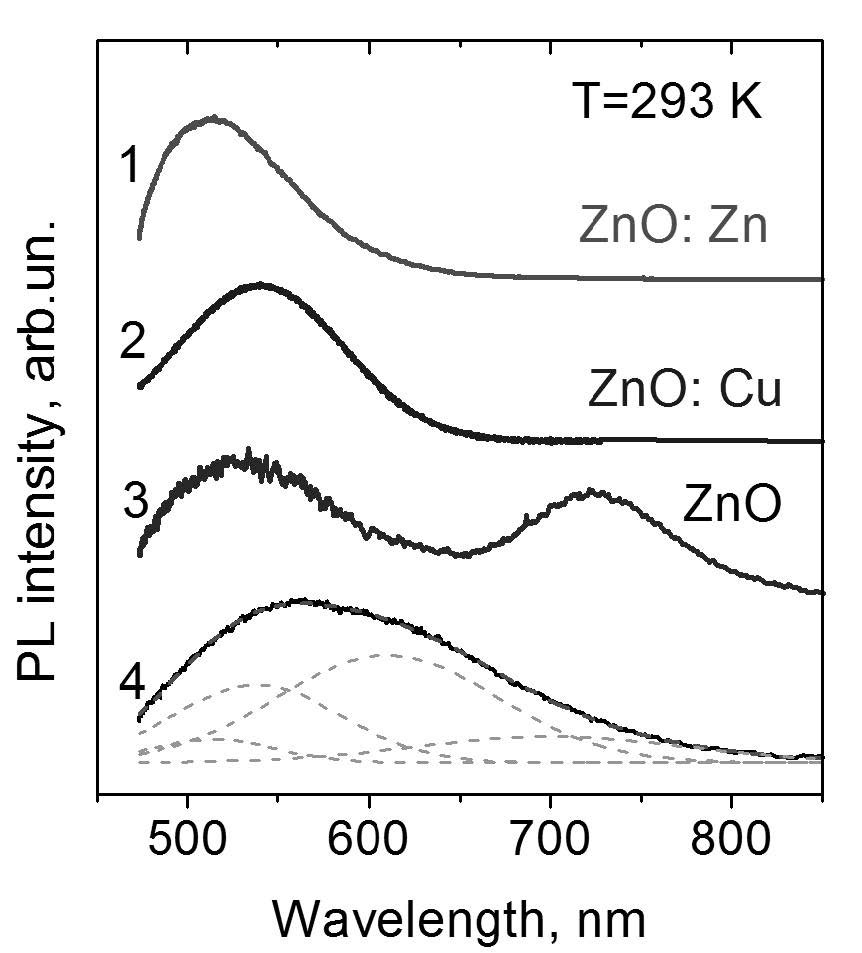
 DownLoad:
DownLoad: 